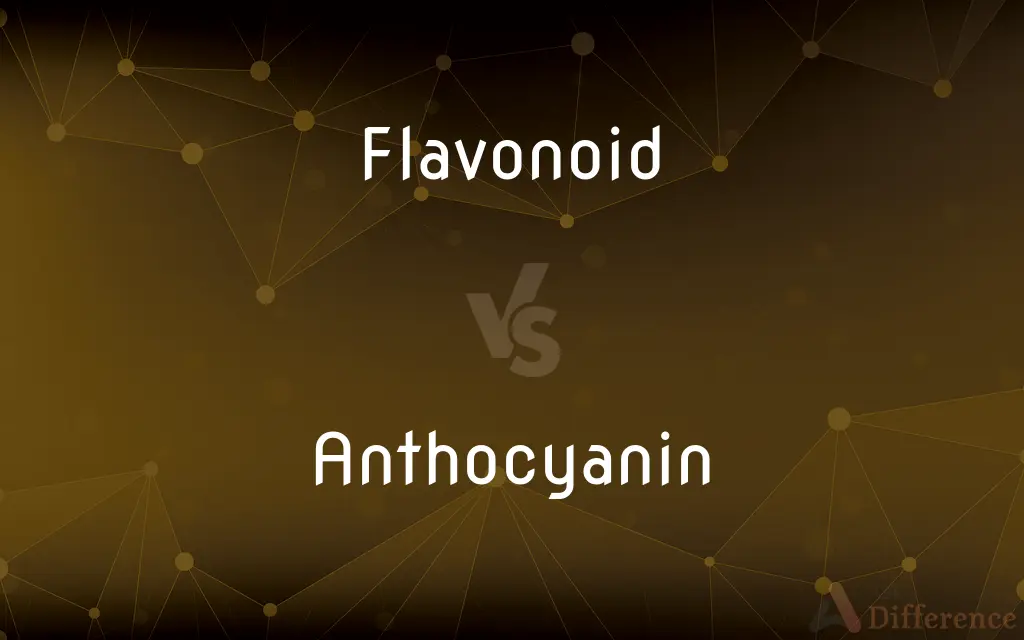Flavonoid vs. Anthocyanin — What's the Difference?
By Maham Liaqat & Urooj Arif — Updated on April 1, 2024
Flavonoids are a diverse group of plant compounds with antioxidant properties, whereas anthocyanins are a type of flavonoid responsible for the red, purple, and blue pigments in plants.

Difference Between Flavonoid and Anthocyanin
Table of Contents
ADVERTISEMENT
Key Differences
Flavonoids encompass a broad category of polyphenolic compounds found in fruits, vegetables, and other plants, known for their antioxidant effects and contribution to plant color, among other health benefits. Anthocyanins, on the other hand, are specific flavonoids that give many fruits and flowers their vibrant red, blue, and purple hues, and they also offer antioxidant benefits.
While flavonoids in general have a wide range of functions in plants, including UV filtration, symbiotic nitrogen fixation, and floral coloration, anthocyanins are particularly noted for their role in attracting pollinators and in protecting plants against various stresses. Anthocyanins are also studied for their potential health benefits in humans, including anti-inflammatory and anti-carcinogenic properties, within the broader context of flavonoid research.
Flavonoids are classified into several categories, including flavones, flavonols, flavanones, isoflavones, and anthocyanins, based on their chemical structure. Anthocyanins are unique among flavonoids for their ability to change color with pH changes, which is not a characteristic of most other flavonoids.
The dietary sources of flavonoids are diverse, including a wide variety of fruits, vegetables, grains, bark, roots, stems, flowers, tea, and wine. Sources of anthocyanins are more specific, largely found in colored berries, grapes, cherries, and purple corn, among others.
In terms of health implications, both flavonoids and anthocyanins are associated with reducing the risk of several chronic diseases, including heart disease and cancer, through their antioxidant properties. However, anthocyanins are particularly researched for their role in improving visual and neurological health, as well as their potential in obesity and diabetes management.
ADVERTISEMENT
Comparison Chart
Definition
A large class of plant-based compounds known for their antioxidant properties.
A type of flavonoid that gives red, purple, and blue pigments to plants.
Functions in plants
UV filtration, nitrogen fixation, coloration, and plant defense.
Attraction of pollinators, protection against environmental stresses, and coloration.
Health benefits
Antioxidant, anti-inflammatory, and potential anti-cancer effects.
All the benefits of flavonoids, with specific impacts on visual and neurological health, and potential in managing obesity and diabetes.
Chemical structure
Varied structures, including multiple subclasses.
Characterized by the presence of glycosidic linkages in their chemical structure, allowing for color change with pH.
Dietary sources
Broad, including fruits, vegetables, tea, and wine.
More specific, mainly found in colored berries, grapes, and cherries.
Compare with Definitions
Flavonoid
A diverse group of phytonutrients present in plants, contributing to their color and offering antioxidant effects.
Quercetin, a flavonoid in onions, has anti-inflammatory properties.
Anthocyanin
Water-soluble pigments responsible for the red, purple, and blue colors of many plants.
Cyanidin in cherries provides their deep red color.
Flavonoid
Plant compounds that play key roles in plant growth and health.
Flavones in celery help protect the plant from pests.
Anthocyanin
A subclass of flavonoids that changes color with pH changes, found in certain fruits and flowers.
The blue color of hydrangeas is due to the anthocyanin delphinidin, which changes hue with soil pH.
Flavonoid
Naturally occurring substances in plants known for their antioxidant capacity.
Isoflavones in soy products are studied for their potential in reducing cancer risk.
Anthocyanin
Natural compounds that offer antioxidant benefits and are linked to various health improvements.
Malvidin in grapes is associated with cardiovascular health.
Flavonoid
Compounds that can influence cellular mechanisms in humans positively.
Hesperidin, a flavonoid in citrus fruits, supports vascular health.
Anthocyanin
Pigments that protect plants from UV radiation and attract pollinators.
Petunidin gives petunias their vibrant purple color.
Flavonoid
Bioactive molecules with health-promoting properties found in a variety of foods.
The flavonoid catechin in green tea is linked to heart health benefits.
Anthocyanin
Specific flavonoids studied for their potential to improve vision and brain health.
Anthocyanins in blueberries are researched for their neuroprotective effects.
Flavonoid
Flavonoids (or bioflavonoids; from the Latin word flavus, meaning yellow, their color in nature) are a class of polyphenolic secondary metabolites found in plants, and thus commonly consumed in the diets of humans.Chemically, flavonoids have the general structure of a 15-carbon skeleton, which consists of two phenyl rings (A and B) and a heterocyclic ring (C, the ring containing the embedded oxygen). This carbon structure can be abbreviated C6-C3-C6.
Anthocyanin
Anthocyanins (also anthocyans; from Greek: ἄνθος (anthos) "flower" and κυάνεος/κυανοῦς kyaneos/kyanous "dark blue") are water-soluble vacuolar pigments that, depending on their pH, may appear red, purple, blue, or black. In 1835, the German pharmacist Ludwig Clamor Marquart gave the name Anthokyan to a chemical compound that gives flowers a blue color for the first time in his treatise “Die Farben der Blüthen”.
Flavonoid
Any of a large group of water-soluble antioxidant compounds, including the anthocyanins, flavonols, flavones, and isoflavonoids, often occurring as glycosides in plants and consisting of two aromatic rings linked by a carbon bridge that often forms a heterocyclic ring. Flavonoids are found in tea, red wine, and a variety of vegetables and fruits.
Anthocyanin
Any of various flavonoid glycoside pigments that impart red, purple, and blue colors to plant parts and are found in berries and other fruits, red wine, and certain vegetables.
Flavonoid
Any of various compounds that are a subset of this group, including the flavones, flavanols, and flavonols, as distinguished from the isoflavonoids. In both senses also called bioflavonoid.
Anthocyanin
Any of many water-soluble red to violet plant pigments related to the flavonoids (more noticeable in autumn after the chlorophyll decomposes)
Flavonoid
(organic chemistry) Any of many compounds that are plant metabolites, being formally derived from flavone; they have antioxidant properties, and sometimes contribute to flavor.
Anthocyanin
Same as Anthokyan.
Common Curiosities
What makes anthocyanins unique among flavonoids?
Anthocyanins are unique for their color-changing properties with pH changes and their vibrant red, purple, and blue pigments.
Are all flavonoids antioxidants?
While most flavonoids have antioxidant properties, their effectiveness can vary based on their chemical structure and the body's ability to absorb them.
What are flavonoids?
Flavonoids are a large group of plant-based compounds known for their antioxidant properties and health benefits.
Are anthocyanins found in all fruits and vegetables?
No, anthocyanins are specifically found in plants with red, purple, or blue pigments, such as berries, grapes, and cherries.
Do flavonoids have any side effects?
Generally, flavonoids consumed through food are safe, but high doses in supplement form may have adverse effects.
How do anthocyanins benefit plant health?
They protect plants from UV radiation, attract pollinators, and defend against environmental stresses.
Can flavonoids improve brain health?
Research suggests that flavonoids, including anthocyanins, may have neuroprotective effects and contribute to improved brain health.
Can flavonoids and anthocyanins reduce the risk of chronic diseases?
Yes, both are associated with reduced risk of several chronic diseases through their antioxidant and anti-inflammatory effects.
Can flavonoids help with weight management?
Some studies suggest that flavonoids, including anthocyanins, may support weight management through their metabolic effects.
Where can I find flavonoids in my diet?
Flavonoids are found in a wide variety of plant-based foods, including fruits, vegetables, tea, and wine.
How do anthocyanins change color with pH?
Anthocyanins can change from red to purple to blue with increasing pH due to changes in their molecular structure.
What role do flavonoids play in plant defense?
Flavonoids can deter herbivores, inhibit pathogens, and protect plants from UV radiation.
Is there a difference in the health benefits of various flavonoids?
Yes, different flavonoids can have varied health benefits, with some having more pronounced effects on certain health conditions than others.
Share Your Discovery

Previous Comparison
Humming vs. Singing
Next Comparison
Plaque vs. PatchAuthor Spotlight
Written by
Maham LiaqatCo-written by
Urooj ArifUrooj is a skilled content writer at Ask Difference, known for her exceptional ability to simplify complex topics into engaging and informative content. With a passion for research and a flair for clear, concise writing, she consistently delivers articles that resonate with our diverse audience.
















































